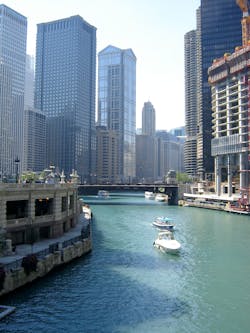The Metropolitan Water Reclamation District of Greater Chicago (MWRD) celebrated its 125th anniversary this past May. Since 1889, the Sanitary District, later named the Metropolitan Water Reclamation District of Greater Chicago, has worked to improve water quality and prevent flooding in our region.
The agency’s first initiative was to reverse the flow of the polluted Chicago River away from Lake Michigan, the source of the city's drinking water, by excavating the Chicago Sanitary and Ship Canal.
Excavating the 28-mile canal took 8,500 workers eight years to complete. The Chicago Sanitary and Ship Canal is often referred to as the “canal that saved Chicago.” Without it, the city was in danger of drowning in its own wastewater.
The waterway system protected the lake from the river's water, but the river itself was still famously polluted. In the early 20th century, the MWRD began developing wastewater treatment technology and building water reclamation plants to clean wastewater before it reached the waterways. Today, the MWRD operates seven water reclamation plants with records of compliance with water quality standards and is developing sustainable new treatment processes.
Historically, the MWRD's treatment plants worked to clean wastewater in dry weather, but during rainstorms, the sewer system could become overwhelmed and overflow to waterways. The MWRD began work on the Tunnel and Reservoir Plan (TARP) or "Deep Tunnel" in the early 1970s to address this problem. TARP consists of more than 100 miles of tunnels and vast reservoirs to capture storm water and sewer overflows. The “tunnel” portion of TARP was completed in 2006 and is fully operational. The “reservoir” portion of TARP is currently under construction. Since it went online, TARP has greatly reduced combined sewer overflows, protected property and improved water quality.
In 2004, the MWRD was granted storm water management authority for Cook County. Since then, it has embarked on constructing major regional flood control projects throughout the county. MWRD is also exploring ways to work with all 125 communities using available technologies to decrease flooding in major rain events, which the city is experiencing on a more routine basis. To prevent future commercial, municipal, and residential development and redevelopment projects from exacerbating flooding, the Board approved the Watershed Management Ordinance (WMO), which provides uniform storm water management regulations for Cook County. The WMO took effect on May 1.
As the MWRD continues through its second century, it is using emerging technologies and processes to support its mission, customers and water environment. MWRD is pursuing sustainable practices, embracing partnerships and implementing available technologies while working together with communities to eliminate flooding.
Source: MWRD


